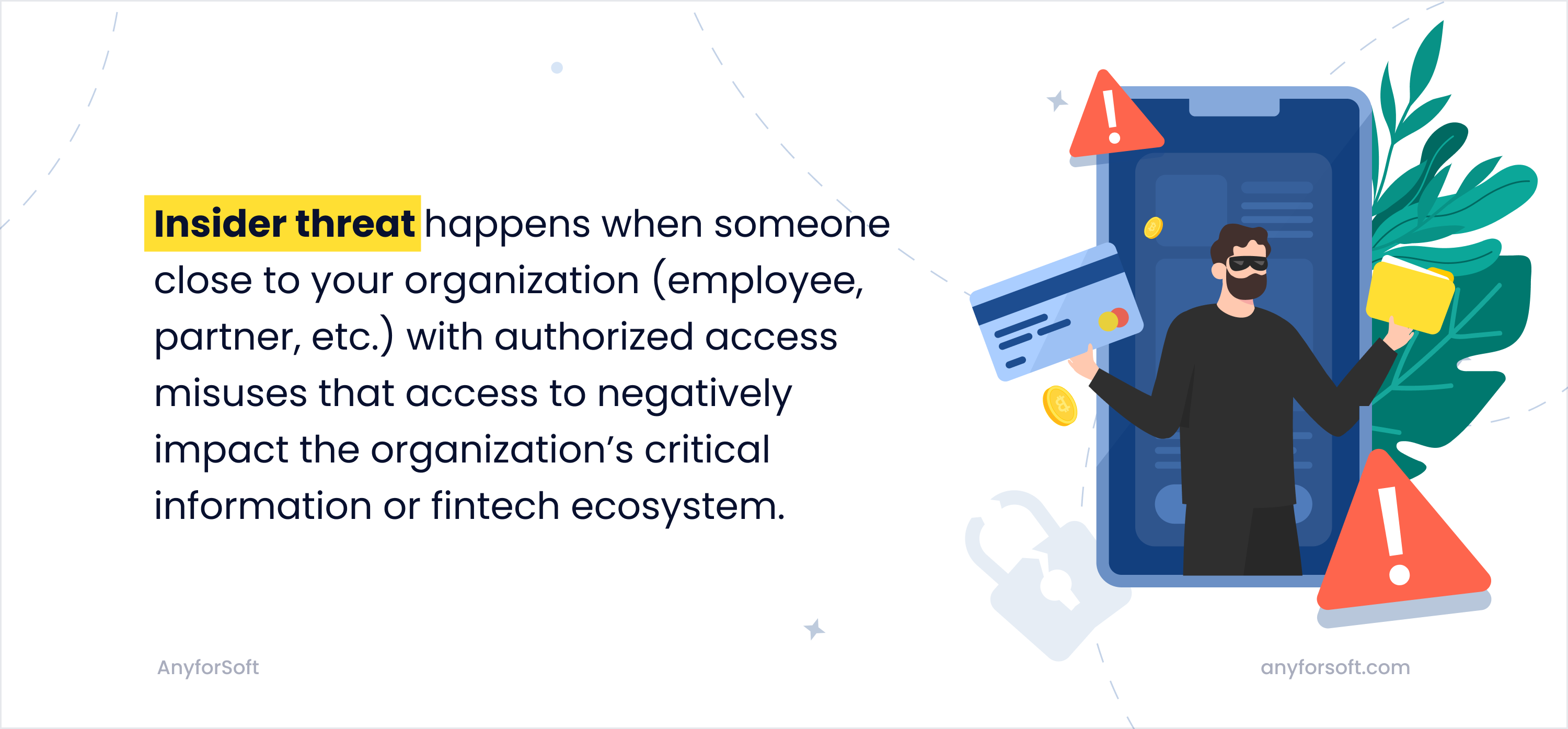In one of our recent articles, we talked about e-commerce security threats and solutions. This time we focus on cybersecurity concerns related to the fintech industry.
Fintech applications deal with gigabytes of sensitive data on a daily basis. Credit card information, financial transactions, account balances, cash flows, user credentials, you name it. No wonder fintech companies are constantly subject to cybersecurity threats, many of which result in significant financial and reputational damage.
For example, in 2017, Equifax, an American credit bureau, experienced a data breach that compromised the private records of 147.9 million American citizens. This led to huge reputational damage, not to mention hundreds of lawsuits from indignant customers. Eventually, the company had to pay $300 million in compensation for the victims.
Don’t want something similar to happen to you?
Then you should take care of fintech cybersecurity right from the beginning.
As a company that specializes in fintech software development, AnyforSoft is here to talk about the most common cyber threats in the fintech industry and show you how to protect from them.
Without further ado, let’s get started.
Why Fintech Cybersecurity is Highly Important
Before we describe the most common security risks fintech firms have to deal with, let us discuss why fintech cybersecurity should be of utmost importance for any organization:
- Data protection. Since fintech companies store virtually the same data as banks and financial organizations, they’re attractive targets for cybercriminals. If you fail to protect your company against malware attacks and don’t close your security vulnerabilities, you will have to deal with a data breach at some point, which will most certainly damage your reputation. Besides, data breaches are very costly, as indicated in the introduction.
- Compliance. Each company that deals that operates in the financial services industry must comply with government regulations in its country. For the US, it’s Payment Card Industry Data Security Standard (PCI DSS) and for the EU, it’s General Data Protection Regulation (GDPR) + other regulations. The fintech compliance with the regulations implies the implementation of various security solutions to protect your customers’ data. If you fail to comply, you will lose your license and hence will not be able to provide fintech services.
As you can see cybersecurity and fintech always go hand in hand. Now if that’s clear, let’s finally take a look at the most widespread security threats in the industry.
Cybersecurity in Fintech: Top 3 Most Common Security Risks
Let’s briefly review the most common cybersecurity issues that fintech organizations and financial institutions deal with.
#1 Identity theft

Identity theft happens when a cybercriminal uses stolen or fake identity information to impersonate someone else and log in to a fintech application. After that, they can steal money and financial data from the account, apply for a loan, or use the account for other fraudulent activities.
This crime can be committed in various ways; the most common are phishing attacks and synthetic identity fraud.
A phishing attack is a cyber attack in which a bad actor makes fraudulent calls or sends emails to trick your fintech company’s workers into providing personal information—in this case, account credentials.
Synthetic identity fraud is when a fraudster combines real and fake information when creating an account on your platform. For example, they may use a real name but provide fake contact information. After that they can, for example, ask for a loan and never pay it back.
How to prevent this cybersecurity threat
- Implement robust security measures for identity verification, such as fingerprint scanning, face identification, and multi-factor authentication.
- Use machine learning and artificial intelligence to automatically detect suspicious activities and prevent financial fraud before it takes place.
- Educate your employees and customers on phishing attacks and spam methods so that they do not click on suspicious links or provide their personal information to scammers.
- Comply with regulations that govern the use and protection of personal and financial information, such as the General Data Protection Regulation (GDPR) for the EU and the Payment Card Industry Data Security Standard (PCI DSS) for the US.
#2 Money laundering

Another common fintech cybersecurity threat is money laundering. Money laundering is the process of hiding the source of money obtained from illegal activities (e.g., drug trafficking, terrorist funding, etc.) and converting it to a clean source.
Since the Fintech industry is novel and innovative, there are many weaknesses and blindspots in its regulation. Money launderers quickly identify these “blind areas” and use them to disguise illegal funds. No need to mention that this poses many risks to your fintech business. To avoid financial and reputational damages associated with money laundering, you must comply with Anti-Money Laundering (AML) regulations.
How to prevent money laundering
- Follow best Know Your Customers (KYC) practices. Before partaking in financial transactions with new clients, you must confirm their identities. For instance, you could require users to take “on-the-spot” photos in the account creation process and then compare these photos with those on their documents. That will ensure secure onboarding. Once the onboarding is done, you must utilize robust identity verification methods (face identification, fingerprint scan, and so on).
- Leverage Customer Due Diligence (CDD). CDD is a set of cybersecurity checks that will help you verify your customers' identities and assess their risk profiles. CDD is a regulatory requirement for any company that enters into business relationships with a customer and is a big part of anti-money laundering (AML) and Know Your Customer (KYC) directives.
- Automate transaction monitoring processes. To avoid fintech cybersecurity risks associated with money laundering, you should invest in the software development of automation fintech solutions. With such tools, you will be able to apply certain monitoring criteria to all transactions and then monitor them in real time. Once the tool detects any suspicious activity, it will notify you, allowing you to react swiftly.
#3 Insider threat

Insider threat happens when someone close to your organization (employee, partner, etc.) with authorized access misuses that access to negatively impact the organization’s critical information or fintech ecosystem. For example, your employee may leak your customers’ personal data and financial information to a third-party company in exchange for money. By the way, this practice is very common among banks and financial institutions.
According to SecurityIntelligence, 60% of data breaches are caused by insider threats. Interestingly, the global average cost of an insider threat was estimated at $15.4 million (as of 2022). In order to protect your clients’ sensitive information, you must know how to deal with insider threats.
How to prevent insider threats
- Evaluate your security policies. Your policies should include procedures to prevent and detect misuse of company resources. Make sure it clearly describes the consequences of committing data theft.
- Screen your employees. Your security team must screen each employee, analyzing their background. In case it deems a certain employee unreliable, you shouldn’t hire them.
- Use physical security measures. You should always monitor employees who have access to your company’s critical data. Make sure they don't have devices they can copy important data to. Also, consider hiring a security team that would prevent suspicious people from entering areas with critical IT objects (such as server rooms).
- Enable surveillance. Monitor all critical facilities in your company with video cameras with motion sensors and night vision.
Conclusion
Fintech and cybersecurity must go hand in hand. No matter how big your organization is, you should timely fix any security vulnerabilities and follow best industry practices to prevent potential fraud and data breaches. This also implies investing in malware protection and cybersecurity software.
Luckily, AnyforSoft has a broad experience in Fintech development, so we create a custom security tool in accordance with your organization’s specifics. Being a customer-oriented company, we always care about the end result and make sure that it fully meets the client’s needs and requirements.
Contact us today and let’s start mutually beneficial cooperation!
